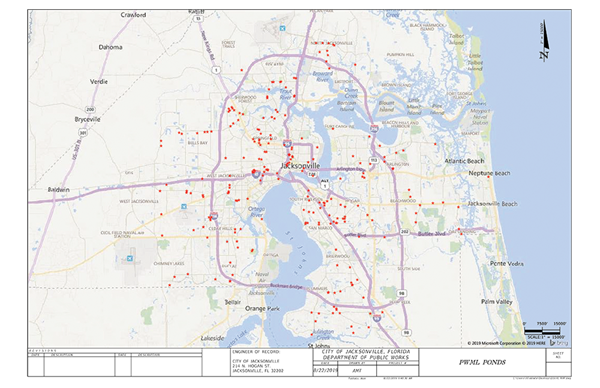Often surrounded by plants and birds, the picturesque setting of a retention pond is inviting. Many are attracted to the still waters, using it for recreational activities, like swimming, boating, and fishing. However, despite its serene appearance, a retention pond is constantly working, serving an important purpose that makes it unsuitable for play, as well as a potential safety hazard.
What is a retention pond, anyway?
Retention ponds are actually functioning stormwater management facilities that help with:
-
Water Quality Treatment - The ponds store the stormwater for a short period of time to allow for sediments (that carry nutrients which adversely impact natural tributaries and rivers) to settle at the bottom of the ponds. This removal of sediments better protects the environment downstream and also ensures our drainage systems have adequate capacity and are not further impacted from sediment buildup (which could restrict flow).
-
Flood Control - The ponds provide an area to store stormwater from rain events and help to limit the rate of flow from the area to eliminate flooding downstream. The stormwater is collected within the City’s drainage system and directed to the ponds, where discharge from the ponds is limited by a discharge structure that restricts flow at a slower rate.
Hmmm…that's interesting, but not dangerous. How can a retention pond be a potential hazard?
-
Steep sides: Retention ponds are built with side slopes that can make it difficult for a person to climb back out.
-
Dangerous currents: Strong currents after a storm at both inlet and outlet areas of a pond can also pose a danger, especially if protective bars or grating is built to close to the drain. These currents can be strong enough to hold a person pinned against the grating, preventing people who would otherwise be able to swim to safety, from doing so.
-
Dirty water: Since retention ponds collect runoff and storm water, they are designed to act as a filtration system before the water moves on into local rivers, lakes and streams. As such, the sediment collected in the depth of these structures can contain heavy metals and contaminates. They can also have toxic algae blooms which can threaten the lives of children and pets or cause serious illness if ingested or placed in direct contact with skin.
Wow, I didn’t know that! What can I do to keep my loved ones and myself safe?
DO NOT
- Swim in a pond
- Fish in a pond
- Play around a pond, especially along the side-bank
- Dump anything in a pond
- Fertilize around a pond
- Try to remove anything from a pond or its adjacent area
DO:
- Keep children supervised
- Contact the City if you see something in a pond
- Contact the City if you observe someone dumping in a pond
- Contact the City if you observe an extremely high water level (near the top of the pond banks) in a pond when there has been no rain event recently (this could indicate some type of restriction to the discharge structure)
Are there a lot of retention ponds in the city? Are they in my neighborhood?
Yes, there are 235 city-managed retention ponds located in Jacksonville; however, the vast majority of ponds are located within neighborhoods and are privately owned and maintained by individual home owners or the homeowners association (HOA).
Click here to view a map of city-managed retention ponds.

What should I do if I fall into a pond?
Remain calm, and try to remove your shoes and any bulky clothing if possible. In addition, call out loudly for help while attempting self-rescue (this can be swimming or floating) until assistance arrives.
What should I do if I see someone fall into a pond?
Call 911. After that, throw a piece of rope or something that floats to the victim if it can be done safely.